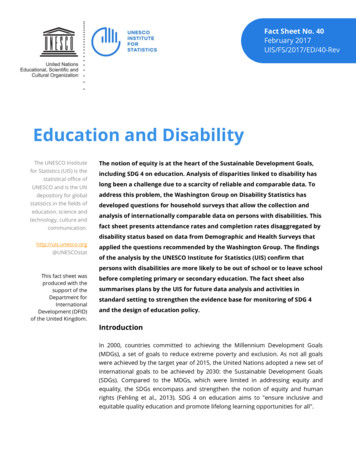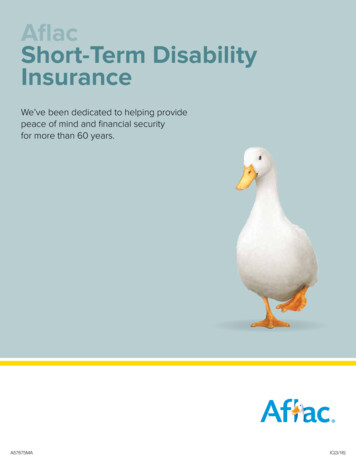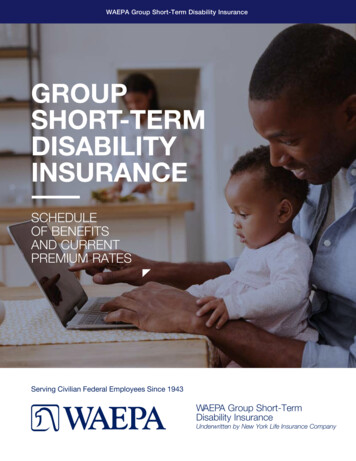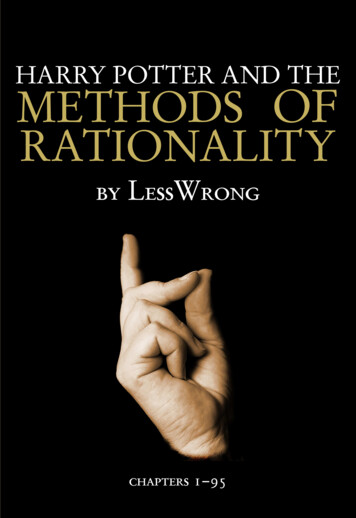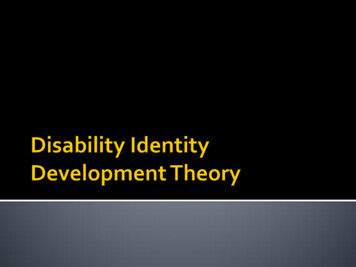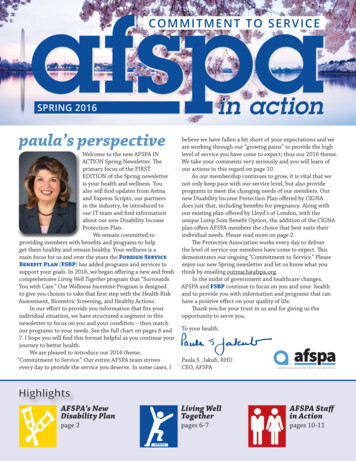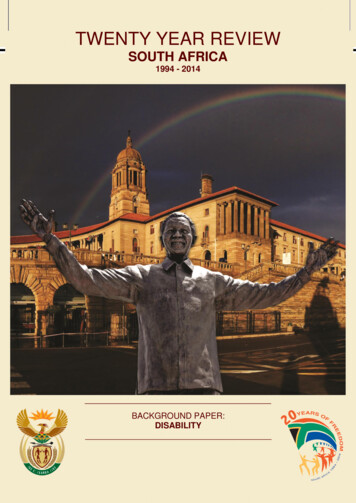
Transcription
BACKGROUND PAPER: DISABILITYTWENTY YEAR REVIEWSOUTH AFRICA1994 - 2014BACKGROUND PAPER:DISABILITY
BACKGROUND PAPER: DISABILITYContact details:Chantelle Van Der BylTel: (012) 312 0102Email: Chantelle@presidency-dpme.gov.zaDisclaimerThe background papers are written by officials in the Presidency and othergovernment departments using inputs from literature reviews, commissionedresearch, government reviews and reports and roundtable discussions with arange of stakeholders. The views reflected in the background papers do notrepresent those of the Presidency, but rather reflect authors’ views on sectordevelopments.2
BACKGROUND PAPER: DISABILITYContentsAcronyms and Abbreviations . 1Executive Summary . 3Review . 81.Introduction and background . 81.1Conceptual framework and purpose . 81.2Methodology and sources of information . 92. The journey since 1994 . 102.1.Understanding of disability and defining the scope . 102.2Dynamics of the transition . 113. Reflection on the journey . 173.1.Moving beyond disability as a health and welfare construct . 173.2Improving equity in access . 193.3White Paper on the Integrated National Disability Strategy . 213.4Institutionalising the principle of self-representation . 213.5Decent work and economic empowerment. 223.6Local participation and partnerships . 234.5.Overcoming challenges and doing things differently . 254.1Adopting a unified definition of disability . 264.2Focus on equality of outcomes . 274.3Prioritising the case of children and youth with special needs . 274.4Comprehensive social security . 294.5.Strengthening the voices of persons with disabilities . 304.6Meeting differing needs – adopting a developmental approach . 314.7.Towards a systems approach for effective disability intervention . 32Summary and recommendations . 33References . 36
BACKGROUND PAPER: DISABILITYAcronyms and ALAMAPANSALBPEPUDAPSCRDPSADASAHRCCommunity Agency for Social EnquiryCommunity-based rehabilitationCommission for Conciliation, Mediation and ArbitrationCommission for Gender EqualityConfidence intervalCompensation for Occupational Injuries and Diseases ActCivil-society organisationDanish International Development AgencyDepartment of Basic EducationDistrict-based Support TeamDepartment of Higher Education and TrainingDepartment of HealthDisabled peoples’ organisationDisabled People South AfricaDepartment of Social DevelopmentDepartment of Women, Children and People with DisabilitiesWhite Paper 6 on Inclusive EducationGeneral Household SurveyHigher Education Disability South AfricaHuman Sciences Research CouncilInformation and communication technologyInternational Labour OrganisationIntegrated National Disability StrategyMedunsa Organisation for Disabled EntrepreneursMpumalanga Provincial GovernmentMen who have sex with menNational Development PlanNational Economic Development and Labour CouncilNon-governmental organisationNational Income Dynamics StudyNational Student Financial Aid SchemeNational Strategic PlanNational Youth Development AgencyOccupational health and safetyOffice on the Status of Disabled PersonsParents of Children with Special Education NeedsPublic Administration Leadership and Management AcademyPan South African Language BoardPromotion of Equality and Prevention of Unfair Discrimination ActPublic Service CommissionReconstruction and Development ProgrammeSouth African Disability AllianceSouth African Human Rights Commission1
BACKGROUND PAPER: s SATBUIFUNUNAIDSUNCRPDUNESCOWHOSouth African Local Government AssociationSouth African National AIDS CouncilSouth African Schools ActSouth African Social Security AgencySchool-based Support TeamSector Education and Training AuthoritySchool governing bodySocial Pension SystemStatistics South AfricaTuberculosisUnemployment Insurance FundUnited NationsJoint United Nations Programme on HIV/AIDSUnited Nations Convention on the Rights of Persons with DisabilitiesUnited Nations Educational, Scientific and Cultural OrganisationWorld Health Organisation2
BACKGROUND PAPER: DISABILITYExecutive SummaryThis review sets out to understand the experience of persons with disabilities and thejourney travelled over the past 18 to 20 years, as well as the extent to which thequality of life of persons with disabilities within South Africa has improved. While thefocus on disability as a thematic area was welcomed across the disability sector, itdoes not detract from the fact that disability should ideally be located and analysedwithin other relevant thematic areas, either through disaggregated data or throughthe acknowledgement of persons with disabilities as a recognised minority group.While the reality of the lack of disaggregated data on disability leaves this approachof conceptualising, positioning and mainstreaming disability within each relevantthematic area a continued challenge, the use of available disaggregated datarequires capacity for, and insight into mainstreaming disability in other thematicareas to contextualise the inequalities persons with disabilities experience.The journey since 1994The new democratic government inherited a society that understood disability to be apersonal tragedy that required a health and welfare response to “fix” the person andthe situation. The ongoing difficulty and debate in measuring disability is reflected inthe changing methodologies adopted over the past 20 years. At the centre of thedebate lies the need for disabled people to be recognised as a distinct group ofpeople with rights and responsibilities like any other citizen of a country, while theycontinue to experience high levels of exclusion and discrimination. Putting aside thedebate on definitions, measures and categories, the essence of the narrative iscaptured in three phases of understanding the dynamics of the transition.Laying the foundation of equality (before 1994–2000)The Disability Rights Charter of 1992 was of significant instrumental value inestablishing the minimum demands of persons with disabilities in preparation fordemocracy in South Africa. This culminated in the inclusion of disability in the nondiscrimination and equality clause (section 9) of the Constitution of South Africa(1996), and was followed by the White Paper on an Integrated National DisabilityStrategy for South Africa. The main vision of the Integrated National DisabilityStrategy (INDS) was “ . a society for all, (where) the needs of all citizens constitutethe basis for planning and policy, and the general systems and institutions of societyare accessible to all” (Office on the Status of Disabled Persons, 1997).Entrenching disability rights in government legislation (2001–2008)Within the context of the revision and redesign of the country’s policies, thedevelopment of several white papers served to inform legislation reform as SouthAfrica moved into the new millennium. This phase also put focus on the developmentof strategies and programmes to guide the implementation of legislation that hadalready been promulgated. As the understanding of disability at the policy levelmoved beyond a health and welfare construct, this new approach had to beconceptualised in the process of addressing the residual effects of apartheid within3
BACKGROUND PAPER: DISABILITYthe health, social development, education, transport, communication andemployment sectors, which are the core areas of service delivery for persons withdisabilities.Strengthening the implementation of policies impacting on disability (2009–2013)South Africa ratified the United Nations Convention on the Rights of Persons withDisabilities (UNCRPD) and its Optional Protocol without reservation in 2007. Thisfinal phase in the twenty year journey since 1994 also observed important legislationand policies that is still needed to address disability issues.Reflection on achievements and reasons for celebrationMoving beyond disability as a health and welfare constructThe journey reflected on throughout the three phases demonstrates that a shift in theunderstanding of disability had to take place for any real and significant progress tooccur in the disability sector. The progress in the policy development stage and itssignificance, from the medical to the social- and rights-based approaches todisability, cannot be sufficiently emphasised. There is overwhelming consensus thatthe INDS presented the turning point for the disability sector in South Africa. Linkeddirectly to the values and policy imperatives of the Reconstruction and DevelopmentProgramme (RDP), it became the starting point of institutionalising change andsetting the scene for the transformation of society and government. The journeydescribed, as well as evidence in the literature on disability, demonstrates that theINDS represented the voice of people with disabilities to influence the developmentof progressive policies and legislation across the relevant sectors.Institutionalising the principle of self-representation of persons with disabilitiesFollowing the development of a rights-based legislative framework, anotherachievement to note is the institutionalisation of the principle of self-representation ofpersons with disabilities. Evidence of representation and participation after 1994 bypersons with disabilities at national, provincial and local spheres of government,including in Parliament demonstrates the shift in attitude within the highest andcritical offices of government and the state. At the level of community and society,organisations of disabled persons and for disabled persons were differentiated atgrassroots level, with the former primarily mobilised for advocacy and change, andthe latter to meet needs through service delivery. These gains in South Africapositively influenced development on the African continent, with 1999–2009 beingdeclared the African Decade of Disabled Persons. This was a result of the efforts ofthe South African government and The Presidency in particular. The Decade ofDisabled Persons was subsequently extended by the African Union to 2010–2019.Improving equity in access to servicesThe Free Health Care Policy for pregnant women and children under the age of sixyears was extended to persons with disabilities in 2002 to facilitate access to healthcare, rehabilitation and assistive devices for indigent persons with disabilities.4
BACKGROUND PAPER: DISABILITYAccess to disability grants and care dependency grants grew steadily after themeans test was revised and the criteria on assessments were relaxed when a panelof professionals other than doctors were able to assess the applications. There isevidence emerging in the first 20 year cycle of South Africa’s democracy of depthand deepening efforts in taking the transformation agenda further.Local participation and developing partnerships to strengthen implementation ofpoliciesWith the overall progress of transition from an apartheid government, transformationof the social agenda and tightening of legislation, attention shifted to theimplementation of policies. This demonstrated the dual processes of governmentinitiatives and civil society organisations intersecting to realise that partnerships areneeded to effectively address the implementation of policies that impact on personswith disabilities. Where these partnerships were developed and strengthenedthrough dialogue, joint planning and monitoring, and accompanied by the sharing ofskills and expertise, visible impact could be seen.Overcoming challenges and doing things differentlyThere is a need to build consensus on how the country can do things differently inchampioning the national disability rights agenda, against the background of the2030 Vision for South Africa and the implementation of the National DevelopmentPlan.Adopting a unified definition of disabilityThe struggle to define disability in a way that accurately and realisticallyencompasses the lived experience of persons with disabilities is a historical one,characteristic of power dynamics, prejudice and the social exclusion of those who donot “belong”. A national dialogue is necessary to clarify the implications of themedical and social model of disabilities in order to effect and accelerate policyimplementation and practice.Focus on equality of outcomes – rethinking the struggle for equity in accessGovernment policies and programmes are designed to meet needs, and resourcesare allocated accordingly for the benefit of the greater public good. The largedisparities between different race groups, geographical locations and between menand women that were inherited resulted in extremely uneven starting points whenidentifying needs, especially for persons with disabilities. In addition, disability doesnot only affect an individual, it affects an entire family (Taylor, 2002).The allocation of resources based on the needs and demands of society is acomplex situation for South Africa, as the democratic changes resulted in conflictingrelations between communities and service providers, and especially between thedisabled community and policy-makers with regard towants/needs anddemand/supply issues. Despite positive trends in participation rates and access to5
BACKGROUND PAPER: DISABILITYservices, the intended outcomes for the majority of persons with disabilities in SouthAfrica have not been achieved within the set time frames and targets, especiallyregarding education and employment. Specific attention is required oninstitutionalising universal design and developing a better understanding of the costof disability to the affected individual and family, as well as the state.Strengthening of the disability movementA vibrant and organised disability sector and in particular a strong representativevoice of persons with disabilities, directly aligns with the call for an “active citizenry”referred to in the NDP in order to ensure policy influence. For the disability sector inparticular, it is demonstrated that without the experience and expertise of disabilityissues by persons with disabilities themselves, policy-makers, service providers andthe public at large will remain ignorant of their needs, or at best, sympathise withpersons with disabilities and respond accordingly. The CRPD therefore requires ofstate parties to involve representative organisations of persons with disabilities in allmatters affecting them, including the monitoring of implementation of the UNCRPD.Meeting differing needs – a developmental approachPersons with disabilities are not a homogenous group and have differing needs andexperiences based on the type and severity of impairment, and the level and extentof attitudinal, physical and communication barriers. This is compounded bydemographic characteristics of age, gender, location, sexual orientation, socioeconomic status, and employment and marriage status. Some of the most vulnerablegroups identified are youths with disabilities, women and children with disabilities,persons with disabilities living in rural areas, persons with intellectual and psychosocial disabilities and deaf persons due to the lack of access to sign language andinterpreters.Towards a systems approach for effective disability interventionAs the understanding of disability moved beyond a health issue, and as the voice ofpersons with disabilities became stronger, the complex nature of ensuring equality ofoutcomes for persons with disabilities unfolded over the twenty year period. A smallachievement in one area had the potential to greatly impact on other dimensions ofwell-being. While access to services improved for the general population, in someinstances it deepened inequalities between able-bodied and disabled citizens. Anintervention in one sector is dependent on outcomes of another. This includes thetiming and pace of delivery, priority choices and resource allocation, and the impacton each other to produce a web of interconnections and inter-relations. Theunderstanding and development of several functional systems within a system ofinclusive design, planning, implementation and monitoring is critical – with disabilitychampions required at every level to ensure oversight and stewardship.6
BACKGROUND PAPER: DISABILITYRecommendationsUniversal access and designArticle 9 of the CRPD requires of governments to undertake appropriate measures toensure that persons with disabilities are able to access, on an equal basis, thephysical environment, public transport, information and communications, as well asother facilities and services open or provided to the public, both in urban and in ruralareas. The most effective tool for achieving this is universal design, which benefitsnot only persons with disabilities, but also the broader diverse population.Accountability and enforcementThe polluter-pays principle should apply when public and private institutions floutconstitutional entitlements and legislation that protect and promote the rights ofpersons with disabilities.PartnershipThe right to live independently and to be included as an equal citizen in one’scommunity requires partnerships between all sectors of society. Public sectorinstitutions and service organizations need to align their services at community levelto provide the seamless support services required to realize this right. Organs of civilsociety need to become active agents of change in fighting discriminatory attitudesand belief systems that push persons with disabilities and their families to themargins of society. Organizations of persons with disabilities, as the representativevoice of persons with disabilities, need to strengthen their footprint at local level toempower persons with disabilities, to advocate for change, and to monitor and actupon rights infringements.7
BACKGROUND PAPER: DISABILITYReview1.Introduction and backgroundBy undertaking reviews after 10 and 15 years of democracy, The Presidency ofSouth Africa set out to understand government’s performance in meeting itsobjectives and improving the quality of life of all South Africans to inform future planson areas of improvement.The Twenty Year Review provides a special opportunity for South Africans to reflecton 20 years of freedom and democracy, and the progress we have made as asociety. Using evidence to measure the achievements made provides the basis uponwhich to identify reasons to acknowledge and celebrate these achievements as acollective, while acknowledging that not all South Africans will have experienced thisfreedom and democracy in the same way, at the same pace and at the same depth,given the challenges that still remain. This is particularly the case for persons withdisabilities in South Africa. The 20-year review provides a unique platform to putspecific focus on the rights of persons with disabilities as one of the key thematicareas identified to include in the review process.1.1Conceptual framework and purposeThis review sets out to understand the experience of persons with disabilities and thejourney travelled over the past 18 to 20 years. Its aim is to determine the extent towhich the quality of life of persons with disabilities in South Africa has improved.While the focus on disability through this dedicated thematic area was welcomedacross the disability sector, it does not detract from the fact that disability shouldideally be located and analysed in other relevant thematic areas of the review, eitherthrough disaggregated data or through acknowledgement of persons with disabilitiesas a recognised minority group in South Africa with the same rights as every othercitizen. The reality of the lack of sufficient disability-disaggregated data leaves thisapproach of conceptualising, positioning and mainstreaming disability across therelevant sectors a continued challenge, although not impossible to overcome.Therefore, the purpose of focusing on disability specifically is to consciously set thescene for the promotion of the rights of persons with disabilities as equal citizenswithin the National Development Plan (NDP), using evidence to assess the past aswell as generate thought-provoking analysis and promote dialogue in order topositively influence change. The social model of disability1 will be used throughoutthis review to analyse the legislative and programmatic outcome of government’sinitiatives, as well as to understand the progress made as a society. The socialmodel of disability shifts the focus from the individual with a disability to the1During the early days of activism and transformation, the social model of disability presented aprogressive way of understanding disability and challenged the medical understanding of impairmentleading to individual tragedy8
BACKGROUND PAPER: DISABILITYattitudinal, environmental and communication barriers that detract from equalparticipation and access.Critical areas of work that need to be addressed will be highlighted, so that thesebecome integrated into other relevant thematic areas in future interventions.1.2Methodology and sources of informationA guiding principle in undertaking the Twenty Year Review was to build on existingknowledge to inform the various thematic areas that were included. Six streams ofinputs were generated: commissioned research (Chappel & Rule, 2013); reflectionsby national and provincial government departments; a scientific literature search fordisability which was undertaken by the Human Sciences Research Council (HSRC);a synthesis of existing research reports on disability informing the work of thePresidency since 1994 including the NDP; inputs generated at the stakeholderroundtable (disabled peoples’ organisations (DPOs), researchers, academics andgovernment officials) held on disability; and information contained in the baselineCountry Report to the United Nations Convention on the Rights of Persons withDisabilities (UNCRPD), approved by Cabinet in April 2013.At the stakeholder roundtable, a reference group, comprising representatives fromthe core service delivery and coordinating departments – the Department of BasicEducation (DBE), the Department of Social Development (DSD), the Department ofHealth (DOH) and the Department of Women, Children and People with Disabilities(DWCPD) – was nominated to synthesise and consolidate the findings. Due to thedifficulty in attending the meeting held in Pretoria, inputs from organisations of andfor persons with disabilities were requested through the DWCPD’s Disability RightsNetwork to reflect on how the past 20 years of democracy impacted on the lives ofpersons with disabilities.It is acknowledged that in the field of disability studies, many research gaps –including a scarcity of data, especially during the first decade of democracy – exist.This makes it impossible to adequately inform policy and practice. For the purposesof this review, there was a dependence on secondary data using desktop researchmethodology. Quantitative data, mainly from the various surveys conducted byStatistics South Africa (Stats SA), the development indicators and other scientificsources (as acknowledged), was used. As this review reflects specifically on theexperience of democracy for persons with disabilities and measures changes ingovernment and society, qualitative data generated through the submissionsreceived in the consultation process of compiling the first UNCRPD Country Reportwas further supplemented by responses received from disability organisationsthrough the Disability Rights Network.This is an evidence-based narrative on 20 years of freedom and democracy in thedisability sector. As such, case studies are used to illustrate and bring home keymessages and lessons learnt to inform plans going forward, but difficult questions9
BACKGROUND PAPER: DISABILITYare also posed to provoke deeper analysis and strengthen national dialogue onrealising the rights of persons with disabilities.This is an evidence-based narrative on 20 years of freedom and democracy in thedisability sector. As such, case studies are used to illustrate and bring home keymessages and lessons learnt to inform plans going forward, but difficult questionsare also posed to provoke thought and strengthen national dialogue on realising therights of persons with disabilities.2. The journey since 19942.1. Understanding of disability and defining the scopeThe new democratic government inherited a society that understood disability to be apersonal tragedy that required a health and welfare response to “fix” the person andsituation2 . Before 1994, programmes designed to meet the needs of persons withdisabilities by government were based on the similar value system about disability,building on the segregated apartheid policies and entrenching further violations ofhuman rights and dignity. Children with disabilities, the majority being white, werefound in segregated special schools, and the majority of adults with disabilities (72.6percent) (Nkeli, 2008: 9) remained unemployed or at best were found in shelteredemployment with no opportunities for career choices. The first democraticgovernment thus inherited a legacy of discrimination, a lack of understanding ofdisability as a human rights issue and social exclusion of persons with disabilities.Few official statistics were available on disability to inform the new democraticgovernment on what constituted disability, where persons with disabilities across therace groups were located and what their socio-economic status was. The firstattempts to measure the prevalence of disability since 1996, as shown in thedistribution of disability among the major population groups in Table 1, demonstratesnot only that disability differs across race groups, but that it is difficult to measure(there are huge differences in distribution between the three data sets). Furthermore,it brings to the fore the fact that disability is a social construct, perceived through thelived experience of the disabled person within a racially biased South Africancontext, and measurement is highly dependent on the questions posed.Table 1: Distribution of disability among the major population1996 : Statistics South Africa, 1996; 19991998 CASE survey6.14.54.85.31999 GHS3.44.52.23.2The on-going difficulty and debate in measuring disability is reflected in the changingmethodologies adopted over the past 18 years. At the centre of the debate lies the2Mike Oliver refers to this as the individual model. The chapter entitled “Disabled People” in SocialPolicy (Alcock, Erksine & May, 2006) provides perspectives on the individual and social models ofdisability in social policy and related service delivery issues.10
BACKGROUND PAPER: DISABILITYneed to be recognized as a distinct group of people with rights and responsibilitieslike other citizens of a country. While policy-makers wanted to understand the extentand consequences of having a disability in order to formulate appropriate policies,allocate resources and develop programmatic responses, persons with disabilitiesembraced the window of opportunity presented by the new democratic dispensationto influence a change in attitudes and bring meaning to their lives. Chappel and Rule(2013) outline three phases that define the journey for persons with disabilities inSouth Africa since 1994. Putting aside the debate on definitions, measures andcategories, the essence of the narrative is captured through these phases inunderstanding the dynamics of the transition, which demonstrate the progress madewithin the disability sector. Table 2 reflects the significant policy developments overthese three phases.2.2Dynamics of the transitionPhase 1: Laying the foundation of equality (pre-1994 to 2000)Persons with disabilities began mobilizing and organizing themselves from the mid1980s in line with growing activism against apartheid, thereby aligning themselveswith the broader liberation movement. Disabled People South Africa (DPSA) wasformed in 1984 by a group of disabled activists to initiate change and createawareness of the rights of persons with disabilities. DPSA adopted a strategy ofbuilding local organizations to create a platform for persons with disabilities toempower themselves. This message spread across the poorest of communities,which started organizing themselves into self-help groups, aligned to DPSA, therebyinitiating the formation of grassroots organizations to address disability anddevelopment. The Disability Rights Cha
significance, from the medical to the social- and rights-based approaches to disability, cannot be sufficiently emphasised. There is overwhelming consensus that the INDS presented the turning point for the disability sector in South Africa. Linked directly to the values and policy imperatives of the Reconstruction and Development


